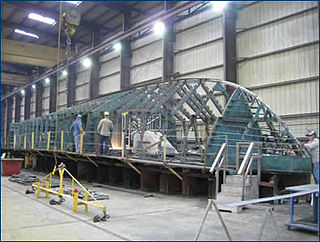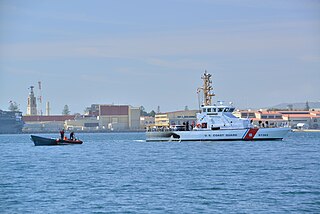
The United States Coast Guard (USCG) is the maritime security, search and rescue, and law enforcement service branch of the United States Armed Forces and one of the country's eight uniformed services. The service is a maritime, military, multi-mission service unique among the United States military branches for having a maritime law enforcement mission with jurisdiction in both domestic and international waters and a federal regulatory agency mission as part of its duties. It is the largest coast guard in the world, rivaling the capabilities and size of most navies.

Naval Submarine Base Kings Bay is a base of the United States Navy located adjacent to the city of St. Marys in Camden County, Georgia, on the East River in southeastern Georgia, and 38 miles (61 km) from Jacksonville, Florida. The Submarine Base is the U.S. Atlantic Fleet's home port for U.S. Navy Fleet ballistic missile nuclear submarines capable of being armed with Trident missile nuclear weapons. This submarine base covers about 16,000 acres of land, of which 4,000 acres are protected wetlands.

The Marine Protector-class patrol boat is a type of coastal patrol boat of the United States Coast Guard. The 87-foot-long (27 m) vessels are based on the Stan 2600 design by Damen Group and were built by Bollinger Shipyards of Lockport, Louisiana. Almost all of these boats have been delivered to the U.S. Coast Guard, which has named them after sea creatures that fly or swim. Four have been delivered to Malta and Yemen.

The Island-class patrol boat is a class of cutters of the United States Coast Guard. 49 cutters of the class were built, of which 3 remain in commission. Their hull numbers are WPB-1301 through WPB-1349.

The USCGC Morgenthau (WHEC-722), was the eighth of twelve 378-foot dual-powered turbine/diesel Hamilton-class high endurance cutters (WHECs) built by Avondale Shipyards in New Orleans, Louisiana. The Coast Guard commissioned the Morgenthau on March 10, 1969. After 48 years of continuous service the U.S. Coast Guard decommissioned the Morgenthau on April 18, 2017, and the ship was sold to Vietnam. On 27 May 2017 the Vietnam Coast Guard commissioned the former cutter as patrol ship CSB 8020.

The Hamilton-class cutter was the largest class of vessel in the United States Coast Guard until replaced by the Legend-class cutter, aside from the Polar-class icebreaker. The hull classification symbol is prefixed WHEC. The cutters are called the Hamilton class after their lead ship, or the "Secretary class" because most of the vessels in the class were named for former Secretaries of the Treasury, with the exception of the "Hero-class cutters" Jarvis, Munro and Midgett.
The history of the United States Coast Guard goes back to the United States Revenue Cutter Service, which was founded on 4 August 1790 as part of the Department of the Treasury. The Revenue Cutter Service and the United States Life-Saving Service were merged to become the Coast Guard per 14 U.S.C. § 1 which states: "The Coast Guard as established January 28, 1915, shall be a military service and a branch of the armed forces of the United States at all times." In 1939 the United States Lighthouse Service was merged into the Coast Guard. The Coast Guard itself was moved to the Department of Transportation in 1967, and on 1 March 2003 it became part of the Department of Homeland Security. However, under 14 U.S.C. § 3 as amended by section 211 of the Coast Guard and Maritime Transportation Act of 2006, upon the declaration of war and when Congress so directs in the declaration, or when the President directs, the Coast Guard operates as a service in the Department of the Navy.
The United States Coast Guard is the coastal defense, search and rescue, and maritime law enforcement branch of the United States Armed Forces and is one of the country's eight uniformed services. It carries out three basic roles, which are further subdivided into eleven statutory missions. The three roles are:

The Point-class cutter was a class of 82-foot patrol vessels designed to replace the United States Coast Guard's aging 83-foot wooden hull patrol boat being used at the time. The design utilized a mild steel hull and an aluminum superstructure. The Coast Guard Yard discontinued building the 95-foot Cape-class cutter to have the capacity to produce the 82-foot Point-class patrol boat in 1960. They served as patrol vessels used in law enforcement and search and rescue along the coasts of the United States and the Caribbean. They also served in Vietnam during the Vietnam War. They were replaced by the 87-foot Marine Protector-class coastal patrol boats beginning in the late 1990s.

The Charleston metropolitan area is an urban area centered around Charleston, South Carolina. The U.S. Office of Management and Budget designates the area as the Charleston-North Charleston, SC Metropolitan Statistical Area, a metropolitan statistical area used for statistical purposes only by the United States Census Bureau and other federal agencies. The OMB defines the area as comprising Berkeley, Charleston and Dorchester counties, an area with 799,636 residents in the 2020 census. Principal cities include Charleston, North Charleston, and Summerville. The area is commonly referred to as the Tri-County Area or the Lowcountry, though the latter term has historically referred to South Carolina's southern coast in general.

USCGC Adak (WPB-1333) was a United States Coast Guard cutter that received her name from Adak Island in the Aleutian Islands of Alaska. Built at Bollinger Shipyard in Lockport, Louisiana, Adak was placed in commission on 18 August 1989 in New Jersey and decommissioned on 30 June 2021 in Manama, Bahrain after almost 32 years of service.

The Damen Stan 2600 is a line of patrol vessels built or designed by Netherlands shipbuilding firm the Damen Group.

Joint Base Charleston is a United States military facility located partly in the City of North Charleston, South Carolina and partly in the City of Goose Creek, South Carolina. The facility is under the jurisdiction of the United States Air Force 628th Air Base Wing, Air Mobility Command (AMC).

Naval Support Activity Charleston, originally designated Naval Weapons Station Charleston, is a base of the United States Navy located on the west bank of the Cooper River, in the cities of Goose Creek and Hanahan South Carolina. The base encompasses more than 17,000 acres (69 km2) of land with 10,000 acres (40 km2) of forest and wetlands, 16-plus miles of waterfront, four deep-water piers, 38.2 miles (61.5 km) of railroad and 292 miles (470 km) of road. The current workforce numbers more than 11,000 with an additional 3,600 people in on-base family housing.

USCGC Walnut (WLB-205) is the fifth cutter in the Juniper-class 225 ft (69 m) of seagoing buoy tenders and is the second ship to bear the name. She is under the operational control of the Commander of the Fourteenth Coast Guard District and is home-ported on Sand Island in Honolulu, Hawaii. Her primary area of responsibility is the coastal waters and high seas around the Hawaiian Islands and American Samoa. Walnut conducts heavy lift aids-to-navigation operations, and law enforcement, homeland security, environmental pollution response, and search and rescue as directed.

USCGC Heriberto Hernandez is the 14th Sentinel-class cutter delivered to the United States Coast Guard. Like five of her sister ships, her initial assignment will see her based in San Juan, Puerto Rico.

USCGC Sea Fox was the last Marine Protector-class coastal patrol boat to be built. Her first home port was Bangor, Washington where she was part of the Coast Guard Maritime Force Protection Unit there, in company with her sister ship USCGC Sea Devil.

USCGC Sea Otter (WPB-87362) is the 61st cutter in the United States Coast Guard's successful Marine Protector class.

USCGC Sea Dragon (WPB-87367) is a decommissioned Marine Protector-class cutter that was assigned to one of two special Maritime Force Protection Units. Each Maritime Force Protection Unit escorts nuclear submarines from one of the United States Navy's two main submarine bases. Sea Dragon was assigned to Naval Submarine Base Kings Bay. The other Maritime Force Protection Unit escorts submarines near Bangor, Washington.

USCGC Terrapin (WPB-87366) is a United States Coast Guard ship of the Marine Protector class. She is assigned to Coast Guard District 13 and is home-ported at Bellingham, Washington. Her main areas of responsibility are the San Juan Islands, the Strait of Juan de Fuca, and Puget Sound. Her missions include search and rescue, law enforcement, and homeland security.



















